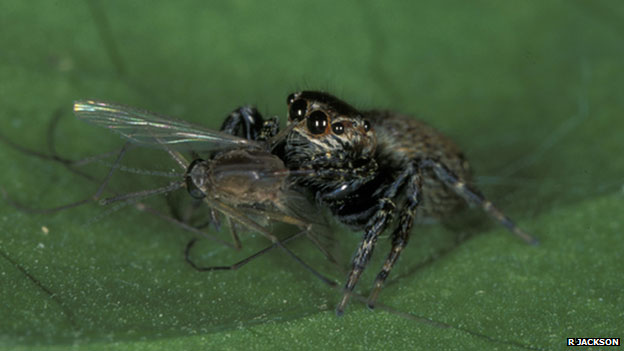how does the bloodthirsty spider choose moof?
A recent scientific study shows that blood-thirsty jumping spiders in eastern Africa detect primitive mosquitoes by observing their antennae.
The BBC says a team of scientists at the University of Canterbury in New Zealand has used the 'hybrid mosquito Frankenstein' and 3D techniques to investigate the diet of these blood-thirsty jumping spiders.
The results show that the spider can detect differences in the antennae and body of the prey when choosing them to attack. These findings were later published in The Journal of Experimental Biology.
'What really surprised me was that I couldn't even see the difference when I looked at the screen,' said Dr. Ximena Nelson of the University of Canterbury.
Spider species Evarcha culicivora, living in Kenya, is one of the species of the Salticidae spiders - a family known for its very fast movement and incredible visibility.

Bloodthirsty spider jumping in Africa.
Blood-thirsty spider is a very special species because it can absorb human blood indirectly by selecting blood-feeding female mosquitoes (especially Anopheles mosquitoes - malaria-carrying mosquitoes).
Usually the male mosquitoes do not suck blood, so for the Evarcha culicivora spiders , they do not have the nutritional benefits like the mosquitoes that stretch their stomach for blood.
After observing that the spiders often eat indirectly from the blood-bearing mosquitoes, Dr. Nelson wondered how the spider could pick the right mosquito among many of the same size animals. attack.
"Obviously, female mosquitoes often have a plump red blood, but they are also different from male mosquitoes in the beard," Dr. Nelson said.
Male mosquitoes are usually hairy, mostly used to detect the scent of females, while the female's antennae are more sparse.
Therefore, scientists decided to test the hypothesis that beard shape is an important factor in selecting a spider's meal by using a variety of male and female mosquitoes to create hybrid mosquitoes. , also known as Frankenstein mosquitoes.
Mosquitoes of Frankenstein are mosquitoes crossed from large bloody female mosquitoes with male mosquitoes, female female mosquitoes and male mosquitoes, or similar hybrids.
The results show that the spider prefers a dead corpse with the blood intact more than anything else, so it can be seen that blood is a major factor when choosing the prey of this spider.
However, when choosing between a female mosquito with a female head and a bloody body with a mosquito with a male head and a body containing blood, the spider often chooses the prey of the female mosquito, although both All of the experiment-bearing species have blood-stained stomachs.
Dr. Nelson then went on to experiment with 3D technology to project images of hybrid mosquitoes between female mosquitoes and male mosquitoes in turn with a bloody body for the spider to see. As a result, three-quarters of the adult spiders came to the prey with their beard heads.
Thus the spider could not simply choose large red Anopheles mosquitoes, blood-filled abdomen, to attack, but they were based on observing prey's antennae.
- The little things people know about spiders
- 10 poisonous spiders are the most feared for humans
- The spider in the United States goes astronaut
- The truth about how spiders move about on a spider web
- How did the spider 'invade' the Earth?
- The bloodthirsty spider species in Africa
- Spiders can release silk to neutralize prey
- Giant spider revives in England
- Detecting 99 million years old spider in mating posture
- How does the spider say 'not' to sex?
- Green spider - high-rise buildings escape
- The spider is strong enough to stop a train
 Why do potatoes have eyes?
Why do potatoes have eyes? 'Tragedy' the world's largest carnivorous life: Death becomes ... public toilet
'Tragedy' the world's largest carnivorous life: Death becomes ... public toilet Tomatoes were once considered 'poisonous' for 200 years
Tomatoes were once considered 'poisonous' for 200 years Detecting microscopic parasites on human face
Detecting microscopic parasites on human face